Astronaut Mae Jemison Working In Spacelab-J
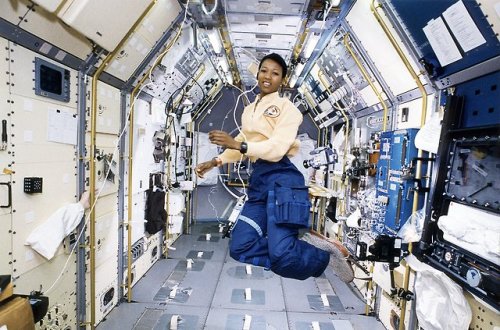
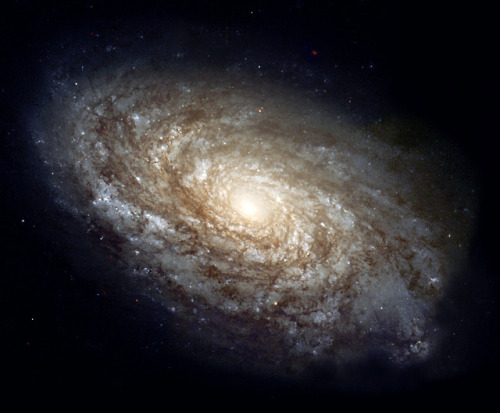
Astronaut Mae Jemison Working in Spacelab-J
Description (October 22, 1992) Space Shuttle Endeavour (STS-47) onboard photo of Astronaut Mae Jemison working in Spacelab-J module. Spacelab-J is a combined National Space Development Agency of Japan (NASDA) and NASA mission. The objectives included life sciences, microgravity and technology research.
Identifier: MSFC-9265609
Magnificant Details in a Dusty Spiral Galaxy
(June 3, 1999) In 1995, the majestic spiral galaxy NGC 4414 was imaged by the Hubble Space Telescope as part of the HST Key Project on the Extragalactic Distance Scale. An international team of astronomers, led by Dr. Wendy Freedman of the Observatories of the Carnegie Institution of Washington, observed this galaxy on 13 different occasions over the course of two months. Images were obtained with Hubble's Wide Field Planetary Camera 2 (WFPC2) through three different color filters. Based on their discovery and careful brightness measurements of variable stars in NGC 4414, the Key Project astronomers were able to make an accurate determination of the distance to the galaxy. The resulting distance to NGC 4414, 19.1 megaparsecs or about 60 million light-years, along with similarly determined distances to other nearby galaxies, contributes to astronomers' overall knowledge of the rate of expansion of the universe. In 1999, the Hubble Heritage Team revisited NGC 4414 and completed its portrait by observing the other half with the same filters as were used in 1995. The end result is a stunning full-color look at the entire dusty spiral galaxy. The new Hubble picture shows that the central regions of this galaxy, as is typical of most spirals, contain primarily older, yellow and red stars. The outer spiral arms are considerably bluer due to ongoing formation of young, blue stars, the brightest of which can be seen individually at the high resolution provided by the Hubble camera. The arms are also very rich in clouds of interstellar dust, seen as dark patches and streaks silhouetted against the starlight.
Image # : PR99-25
More Posts from Womeninspaceexploration and Others


Chawla prepares the CM for installation of MIST in the SH during STS-107
STS-107 Mission Specialist 2 MS Kalpana 'KC' Chawla reads a checklist in the Spacehab SH Research Double Module RDM as she prepares the Combustion Module CM-2 for installation of the Water Mist Fire Suppression Experiment MIST.
Kalpana Chawla
(March 17, 1962 – February 1, 2003) was an American astronaut, engineer, and the first female of Indian origin to go to space. She first flew on Space Shuttle Columbia in 1997 as a mission specialist and primary robotic arm operator. In 2003, Chawla was one of the seven crew members who died in the Space Shuttle Columbia disaster when the spacecraft disintegrated during its re-entry into the Earth's atmosphere. Chawla was posthumously awarded the Congressional Space Medal of Honor, and several streets, universities and institutions have been named in her honor.
Hubble Looks Into a Cosmic Kaleidoscope
At first glance, this cosmic kaleidoscope of purple, blue and pink offers a strikingly beautiful — and serene — snapshot of the cosmos. However, this multi-colored haze actually marks the site of two colliding galaxy clusters, forming a single object known as MACS J0416.1-2403 (or MACS J0416 for short).
MACS J0416 is located about 4.3 billion light-years from Earth, in the constellation of Eridanus. This image of the cluster combines data from three different telescopes: the NASA/ESA Hubble Space Telescope (showing the galaxies and stars), the NASA Chandra X-ray Observatory (diffuse emission in blue), and the NRAO Jansky Very Large Array (diffuse emission in pink). Each telescope shows a different element of the cluster, allowing astronomers to study MACS J0416 in detail.
As with all galaxy clusters, MACS J0416 contains a significant amount of dark matter, which leaves a detectable imprint in visible light by distorting the images of background galaxies. In this image, this dark matter appears to align well with the blue-hued hot gas, suggesting that the two clusters have not yet collided; if the clusters had already smashed into one another, the dark matter and gas would have separated. MACS J0416 also contains other features — such as a compact core of hot gas — that would likely have been disrupted had a collision already occurred.
Together with five other galaxy clusters, MACS J0416 is playing a leading role in the Hubble Frontier Fields program, for which this data was obtained. Owing to its huge mass, the cluster is in fact bending the light of background objects, acting as a magnifying lens. Astronomers can use this phenomenon to find galaxies that existed only hundreds of million years after the big bang.
For more information on both Frontier Fields and the phenomenon of gravitational lensing, see Hubblecast 90: The final frontier.
Text credit: European Space Agency Image credit: NASA, ESA, CXC, NRAO/AUI/NSF, STScI, and G. Ogrean (Stanford University), Acknowledgment: NASA, ESA, and J. Lotz (STScI), and the HFF team
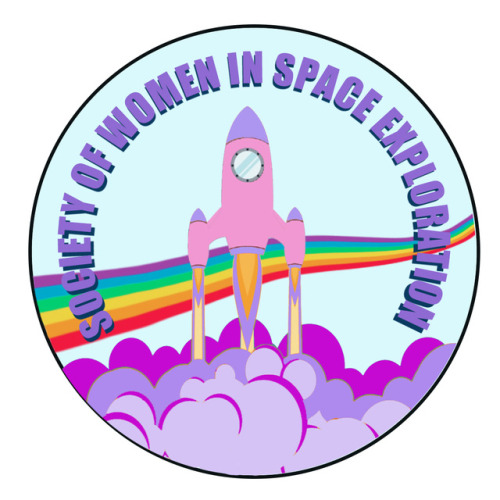
Society of Women in Space Exploration
https://www.swise.org
Interview with Bianca Vasquez - Founder
1. Can you share a bit about yourself and what you do?
I am a mechanical engineering student at Santa Barbara City College. I will be transferring to university within the next year or two. When I'm not doing school related work, I run the Society of Women in Space Exploration, an organization that provides a platform for young girls in college to learn more about themselves as young professionals and future leaders and allow for them to take on a leadership role in their community.
2. What made you interested in space/space exploration?
Like most people interested in space, the curiosity. There are so many questions that come with space that we have about the past, the present, and the future of our universe. What really got me excited about pursuing it, was learning about many of the incredible women that contribute to the discoveries and innovation and how although they are a minority in the field, they own it and continue to thrive and be examples for other young girls that wish to follow in their footsteps! Representation matters and having role models can really affect the way you feel about your goals.
3. What are some challenges you’ve had to face within this field?
I've dealt a lot with imposter syndrome. Space exploration, and STEM in general, is highly competitive. When you do not grow up with the resources and the representation, you start to doubt your abilities. For a few years in college I was in and out of pursuing STEM because I didn't know if I belonged. The truth is, anyone that wants to do this belongs. We need to give more girls and minorities the confidence to follow their dreams, and when more of us do, we open doors for others after us. We wonder why so many women drop out of STEM in general.. it's not because they don't like it, it's because things can be hard when you feel isolated and underrepresented. I've found that I do better when I am around people that are inclusive, welcoming, encouraging, and resemble me somehow. Whether that's other Latinos, other women, or just like minded people.
4. What do you hope to achieve with your society?
I truly hope Society of Women in Space Exploration (SWISE) encourages other girls to pursue their space dreams. I want SWISE to bring girls with similar ambitions together and develop lifelong friendships and genuine bonds + support systems. We do better when we uplift each other and support each other. I hope SWISE positively affects these girls and changes the way they feel about being a minority in the industry; by seeing it as a strength rather than a setback.
5. Some of your inspirations and why?
I do not have a specific dream job (yet) because there are so many things out there, and I am constantly growing and learning more about myself, but I do know that I want to be happy with what I end up doing, and work with positive, innovative people that want to change the world for the better. To work on things that will be sent to space to further our knowledge on the universe would be awesome!!
6. Anything else you’d like to share? (personal experiences/ advice for other women)
Diversity is so so so important. When we have a diverse group of people working to fix a problem, we hear things from different perspectives. We operate with so much context- our backgrounds, our experiences, our way of doing things. Diversity in thought = diversity in solutions. That goes for any field. Diversity in space exploration is extremely key because space is the biggest thing out there. It's not man made, and we can't control it. We can only understand it, and in order to do so, we need all the greatest, most innovative and curious minds we can get!
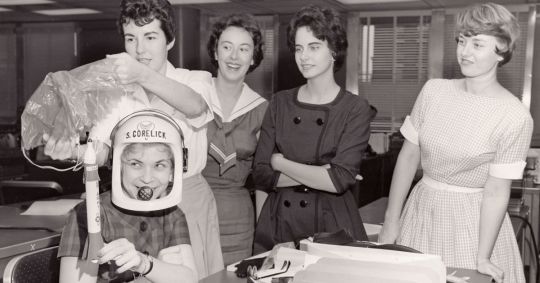
Facts About Women in Space Exploration
1. In 1963 Valentina Tereshkova became the first woman sent to space, just two years after her male counterpart Yuri Gagarin. (only 12 other men had been to space at the time) article
2. Women make up less than 11 percent of history’s space explorers.
3. 538 total space travelers, 62 have been women.
4. A span of 19 years separated the first and second women in space.
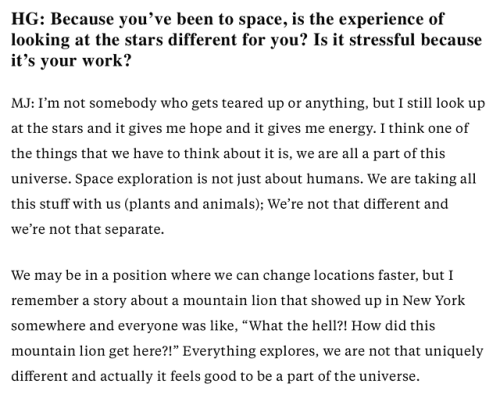
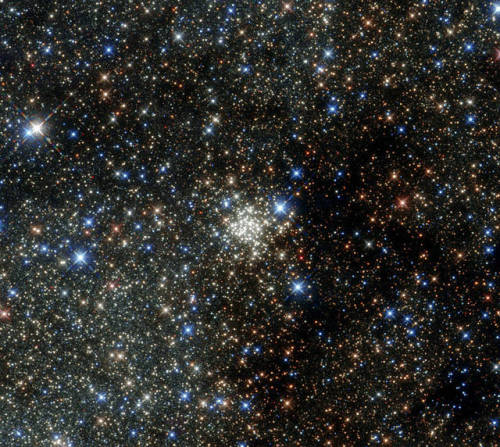
Interview with Mae Jemison
https://hellogiggles.com/news/first-african-american-woman-astronaut-mae-jemison-talks-to-us-about-going-to-mars/
Arches Cluster
This NASA/ESA Hubble Space Telescope image presents the Arches Cluster, the densest known star cluster in the Milky Way. It is located about 25,000 light-years from Earth in the constellation of Sagittarius (The Archer), close to the heart of our galaxy, the Milky Way. It is, like its neighbor the Quintuplet Cluster, a fairly young astronomical object at between two and four million years old.
The Arches cluster is so dense that in a region with a radius equal to the distance between the sun and its nearest star there would be over 100,000 stars! At least 150 stars within the cluster are among the brightest ever discovered in the Milky Way. These stars are so bright and massive that they will burn their fuel within a short time (on a cosmological scale that means just a few million years). Then they will die in spectacular supernova explosions. Due to the short lifetime of the stars in the cluster the gas between the stars contains an unusually high amount of heavier elements, which were produced by earlier generations of stars.
Despite its brightness the Arches Cluster cannot be seen with the naked eye. The visible light from the cluster is completely obscured by gigantic clouds of dust in this region. To make the cluster visible astronomers have to use detectors which can collect light from the X-ray, infrared, and radio bands, as these wavelengths can pass through the dust clouds. This observation shows the Arches Cluster in the infrared and demonstrates the leap in Hubble’s performance since its 1999 image of same object.
Image credit: NASA/ESA Text credit: European Space Agency


Materials Science Experiments Conducted at MSFC
In another first for NASA, an all-female crew of scientific experimenters began a five-day exercise on December 16, 1974, to test the feasibility of experiments that were later tested on the Space Shuttle/Spacelab missions. The experimenters, Dr. Mary H. Johnston (seated, left), Ann F. Whitaker and Carolyn S. Griner (standing, left to right), and the crew chief, Doris Chandler, spent spend eight hours each day of the mission in the Marshall Space Flight Centers General Purpose Laboratory (GPL). They conducted 11 selected experiments in materials science to determine their practical application for Spacelab missions and to identify integration and operational problems that might occur on actual missions.
Image # :565782
Date: November 13, 1974
N81 in the Small Magellanic Cloud
A NASA Hubble Space Telescope "family portrait" of young, ultra-bright stars nested in their embryonic cloud of glowing gases. The celestial maternity ward, called N81, is located 200,000 light-years away in the Small Magellanic Cloud (SMC), a small irregular satellite galaxy of our Milky Way. Hubble's exquisite resolution allows astronomers to pinpoint 50 separate stars tightly packed in the nebula's core within a 10 light- year diameter - slightly more than twice the distance between earth and the nearest star to our sun. The closest pair of stars is only 1/3 of a light-year apart (0.3 arcseconds in the sky). This furious rate of mass loss from these super-hot stars is evident in the Hubble picture that reveals dramatic shapes sculpted in the nebula's wall of glowing gases by violent stellar winds and shock waves. A pair of bright stars in the center of the nebula is pouring out most of the ultraviolet radiation to make the nebula glow. Just above them, a small dark knot is all that is left of the cold cloud of molecular hydrogen and dust the stars were born from. Dark absorption lanes of residual dust trisect the nebula. The nebula offers a unique opportunity for a close-up glimpse at the firestorm' accompanying the birth of extremely massive stars, each blazing with the brilliance of 300,000 of our suns. Such galactic fireworks were much more common billions of years ago in the early universe, when most star formation took place. The "natural- color" view was assembled from separate images taken with the Wide Field and Planetary Camera 2, in ultraviolet light and two narrow emission lines of ionized Hydrogen (H-alpha, H-beta).
Image # : PR98-25
Date: September 24, 1997
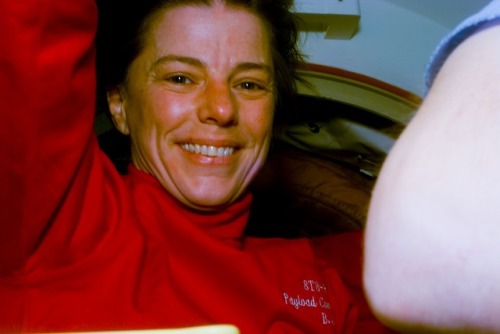
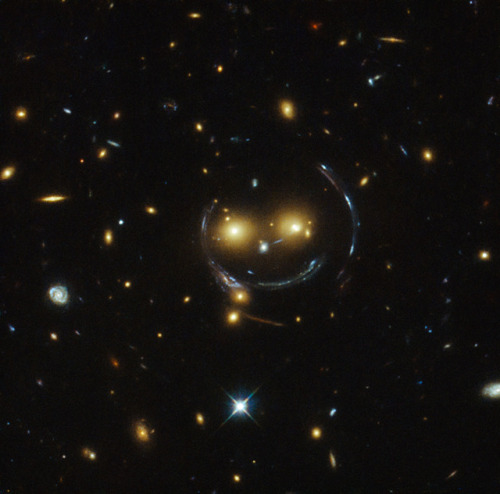
Scenes from the STS-89/Mir 24 welcome ceremony
NASA ID: s89e5175
Date Created: 1998-03-04
S89-E-5175 (24 Jan 1998) --- This Electronic Still Camera (ESC) image shows astronaut Bonnie J. Dunbar, payload commander, shortly after Shuttle/Mir docking activities began. "Deja-vu" may have come to the mind of Dunbar as she boarded Russia's Mir Space Station. Dunbar was a member of the STS-71 crew -- the first United States aggregation to visit Mir -- along with cosmonaut Anatoliy Y. Solovyev, Mir-24 commander. The ESC view was taken at 22:37:23 GMT, on January 24, 1998.
Hubble Sees A Smiling Lens
NASA ID: GSFC_20171208_Archive_e000791
Date Created: 12/8/2017
In the center of this image, taken with the NASA/ESA Hubble Space Telescope, is the galaxy cluster SDSS J1038+4849 — and it seems to be smiling. You can make out its two orange eyes and white button nose. In the case of this “happy face”, the two eyes are very bright galaxies and the misleading smile lines are actually arcs caused by an effect known as strong gravitational lensing. Galaxy clusters are the most massive structures in the Universe and exert such a powerful gravitational pull that they warp the spacetime around them and act as cosmic lenses which can magnify, distort and bend the light behind them. This phenomenon, crucial to many of Hubble’s discoveries, can be explained by Einstein’s theory of general relativity. In this special case of gravitational lensing, a ring — known as an Einstein Ring — is produced from this bending of light, a consequence of the exact and symmetrical alignment of the source, lens and observer and resulting in the ring-like structure we see here. Hubble has provided astronomers with the tools to probe these massive galaxies and model their lensing effects, allowing us to peer further into the early Universe than ever before. This object was studied by Hubble’s Wide Field and Planetary Camera 2 (WFPC2) and Wide Field Camera 3 (WFC3) as part of a survey of strong lenses. A version of this image was entered into the Hubble’s Hidden Treasures image processing competition by contestant Judy Schmidt. Image Credit: NASA/ESA
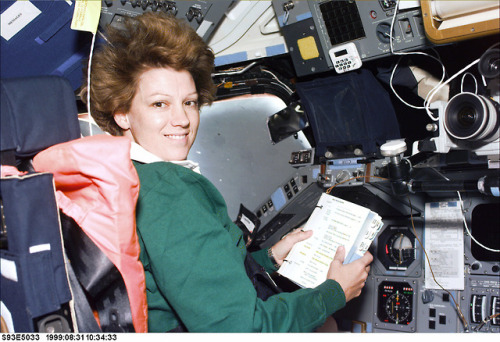
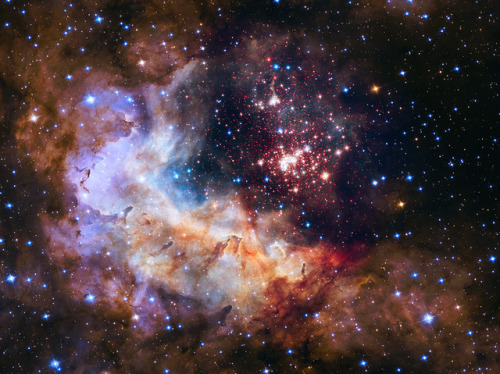
Columbia Commander Eileen Collins
(July 24, 1999) Commander Eileen Collins consults a checklist while seated at the flight deck Commander's station in the Shuttle Columbia during STS-93.
Image # : S93E5033
Hubble Space Telescope Celebrates 25 Years of Unveiling the Universe
The brilliant tapestry of young stars flaring to life resemble a glittering fireworks display in the 25th anniversary NASA Hubble Space Telescope image to commemorate a quarter century of exploring the solar system and beyond since its launch on April 24, 1990.
The sparkling centerpiece of Hubble's silver anniversary fireworks is a giant cluster of about 3,000 stars called Westerlund 2, named for Swedish astronomer Bengt Westerlund, who discovered the grouping in the 1960s. The cluster resides in a raucous stellar breeding ground known as Gum 29, located 20,000 light-years away from Earth in the constellation Carina.
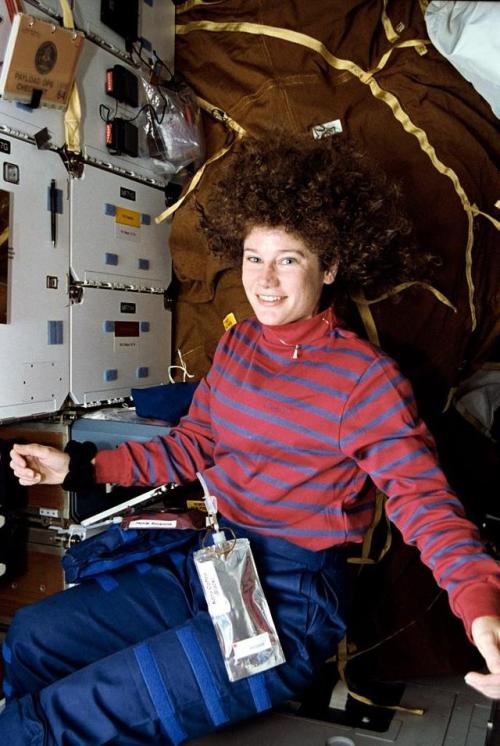
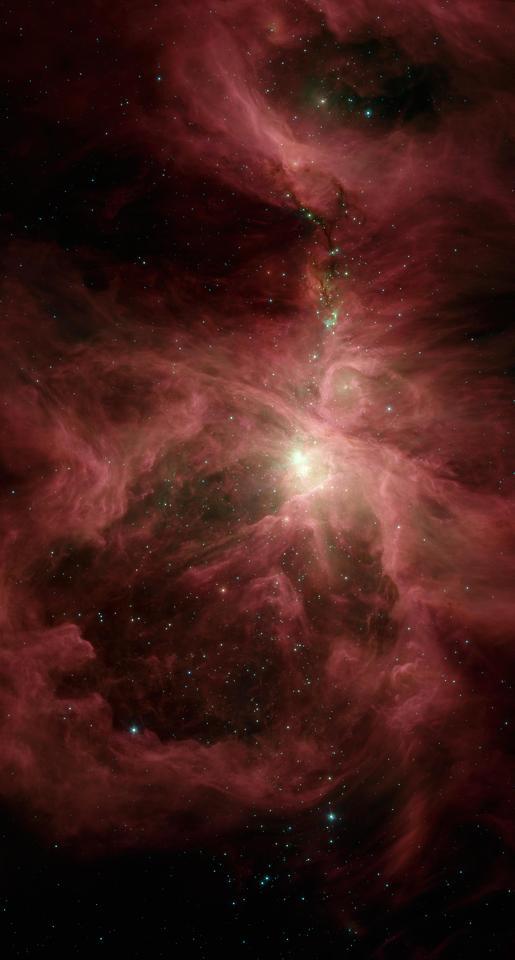
The Sword of Orion
NASA ID: PIA08653
Date Created: 2006-08-15
This image from NASA Spitzer Space Telescope shows the Orion nebula, our closest massive star-making factory, 1,450 light-years from Earth. The nebula is close enough to appear to the naked eye as a fuzzy star in the sword of the constellation.
Tampons were packed with their strings connecting them, like a strip of sausages, so they wouldn’t float away. Engineers asked Ride, “Is 100 the right number?” She would be in space for a week. “That would not be the right number,” she told them. At every turn, her difference was made clear to her. When it was announced Ride had been named to a space flight mission, her shuttle commander, Bob Crippen, who became a lifelong friend and colleague, introduced her as “undoubtedly the prettiest member of the crew.” At another press event, a reporter asked Ride how she would react to a problem on the shuttle: “Do you weep?”
Astronaut Sally Ride and the Burden of Being “The First” (via dinosaurparty)
